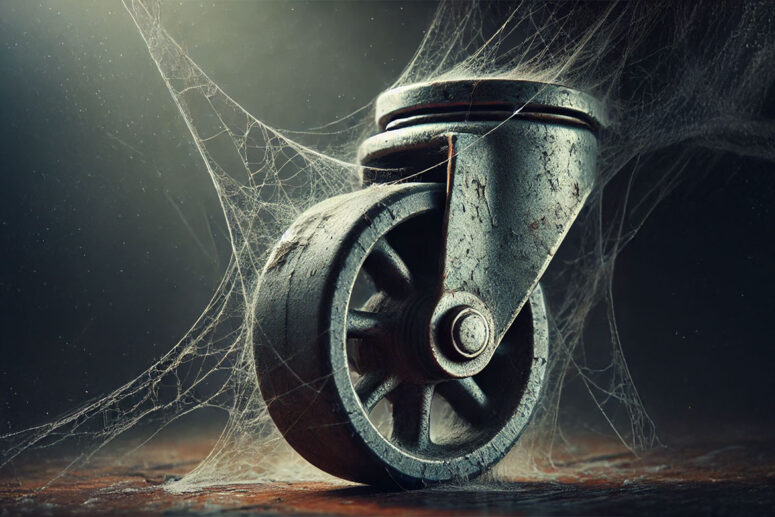Choosing the right casters and maintaining them properly are essential steps to protect your mobility investment. However, casters often lurk in the shadows, out of sight and mind, until something starts creaking in the night. Yet, there can be some precious cargo riding on those wheels, and if one or more fails, it can cost you dearly. At the very least, failed casters are a real nightmare because you have to drop everything and give them your immediate attention. To help you recognize when the mobility monsters are at work and it’s time to call Caster 911, this issue of CasterU highlights a few telltale signs that your casters might be on their last legs—or wheels.
1. Unsettling Noises
If your casters are screeching or rattling like a ghostly wail, they’re likely crying out for some lubrication. Casters should be lubricated twice a year to keep the wheels rolling smoothly. If strange noises persist, it might be due to a seizing wheel bearing, an incorrect bearing type, or even a worn rig/yoke. Sometimes, these eerie sounds indicate a caster misalignment that needs fixing before things get truly scary. It could be like hearing the floorboards creak when no one’s home–your first sign that something is coming back to haunt you.
2. Push/Pull Predicaments
If pushing equipment feels like hauling a trap filled with angry spirits, it’s probably rust or corrosion haunting your caster. Casters running at excessive speeds can also overheat and damage the hub, diminishing performance. If turning becomes a problem, the culprit could be brinelling—a condition where ball bearings create grooves in the raceway, limiting the caster’s swivel range. It’s like trying to run from a ghost in a nightmare–no matter how hard you push, you’re not going anywhere fast.
3. Uneven Wheel Wear or Flat Spots
Flat spots on your wheels might indicate foreign materials like thread, dirt, or even stray metal binding the wheels. Alternatively, it could mean the wheel material isn’t a good match for the temperature or conditionsit’s being used in. Think of it like rolling through a maze of spiderwebs–you keep getting tangled, and every rotation only slows you down.
4. Frame Distortion
This spine-chilling issue often arises from exceeding load capacities or experiencing excessive impact loads—like encountering a bump that magnifies the weight beyond what the casters can handle. Over time, this leads to a distorted frame that needs careful attention.
5. Top Plate Separation
If equipment goes over an unexpected obstacle or faces severe conditions, the top plate might bend and detach. This could also hint that the wrong hardware or washers were used during installation—creating a ghoulish situation no one wants to face. It’s like a vampire’s coffin lid coming off–nothing stays in place when it’s needed most.
6. Bent Stem or Kingpin
Collisions with other equipment or impacts with obstacles can leave your casters with bent stems or kingpins. Additionally, uneven loads can place excess strain on a single caster, leading to warping or contortion over time. It would be like a skeleton missing a few crucial bones–everything’s left unstable and on the verge of collapse.
If you encounter any of the signs above, it’s an emergency—your casters likely need to be replaced. However, the best way to avoid a 911 call is to use the right caster specifications from the start and maintain them properly. For expert advice to keep your mobility nightmares at bay, reach out to your local Algood sales representative or a member of our customer support team.

